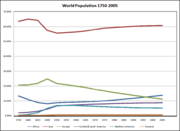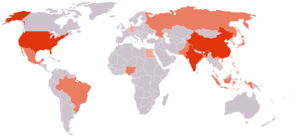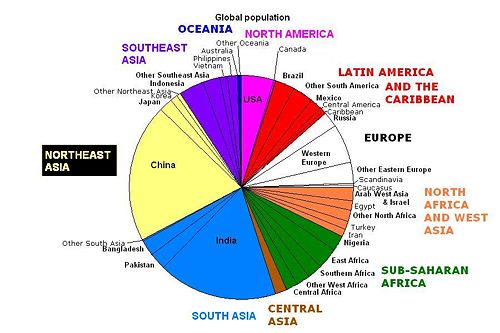World population
2008/9 Schools Wikipedia Selection. Related subjects: Geography
The world population is the total number of living humans on Earth at a given time. As of July 8, 2008, the world's population is believed to be approximately 6,708,700,100. In line with population projections, this figure continues to grow at rates that were unprecedented before the 20th century, although the rate of increase has almost halved since its peak of 2.2 percent per year, which was reached in 1963. The world's population, on its current growth trajectory, is expected to reach nearly 9 billion by the year 2042.
Population figures
Censuses taken between 300–400 CE showed over 50 million people living in the combined eastern and western Roman empire.(citation Dr. Kenneth W. Harl, tulane.edu)
Below is a table with historical and predicted population figures shown in millions. The availability of historical population figures varies by region. (Note: These projections here are not kept up to date.) Please see World population estimates for more figures.
| Region | 1750 | 1800 | 1850 | 1900 | 1950 | 1999 | 2050 | 2150 |
|---|---|---|---|---|---|---|---|---|
| World | 791 | 978 | 1,262 | 1,650 | 2,521 | 5,978 | 8,909 | 9,746 |
| Africa | 106 | 107 | 111 | 133 | 221 | 767 | 1,766 | 2,308 |
| Asia | 502 | 635 | 809 | 947 | 1,402 | 3,634 | 5,268 | 5,561 |
| Europe | 163 | 203 | 276 | 408 | 547 | 729 | 628 | 517 |
| Latin America and the Caribbean * | 16 | 24 | 38 | 74 | 167 | 511 | 809 | 912 |
| Northern America * | 2 | 7 | 26 | 82 | 172 | 307 | 392 | 398 |
| Oceania | 2 | 2 | 2 | 6 | 13 | 30 | 46 | 51 |
| Region | 1750 | 1800 | 1850 | 1900 | 1950 | 1999 | 2050 | 2150 |
|---|---|---|---|---|---|---|---|---|
| World | 100 | 100 | 100 | 100 | 100 | 100 | 100 | 100 |
| Africa | 13.4 | 10.9 | 8.8 | 8.1 | 8.8 | 12.8 | 19.8 | 23.7 |
| Asia | 63.5 | 64.9 | 64.1 | 57.4 | 55.6 | 60.8 | 59.1 | 57.1 |
| Europe | 20.6 | 20.8 | 21.9 | 24.7 | 21.7 | 12.2 | 7.0 | 5.3 |
| Latin America and the Caribbean * | 2.0 | 2.5 | 3.0 | 4.5 | 6.6 | 8.5 | 9.1 | 9.4 |
| Northern America * | 0.3 | 0.7 | 2.1 | 5.0 | 6.8 | 5.1 | 4.4 | 4.1 |
| Oceania | 0.3 | 0.2 | 0.2 | 0.4 | 0.5 | 0.5 | 0.5 | 0.5 |
| Year | World | Africa | Asia | Europe | Latin America * | Northern America* | Oceania | Notes |
|---|---|---|---|---|---|---|---|---|
| 70,000 BCE | 2 | |||||||
| 10,000 BCE | 1,000 | |||||||
| 9000 BCE | 3,000 | |||||||
| 8000 BCE | 5,000 | |||||||
| 7000 BCE | 7,000 | |||||||
| 6000 BCE | 10,000 | |||||||
| 5000 BCE | 15,000 | |||||||
| 4000 BCE | 20,000 | |||||||
| 3000 BCE | 25,000 | |||||||
| 2000 BCE | 35,000 | |||||||
| 1000 BCE | 50,000 | |||||||
| 500 BCE | 100,000 | |||||||
| 1 | 200,000 | |||||||
| 1000 | 310,000 | |||||||
| 1750 | 791,000 | 106,000 | 502,000 | 163,000 | 16,000 | 2,000 | 2,000 | |
| 1800 | 978,000 | 107,000 | 635,000 | 203,000 | 24,000 | 7,000 | 2,000 | |
| 1850 | 1,262,000 | 111,000 | 809,000 | 276,000 | 38,000 | 26,000 | 2,000 | |
| 1900 | 1,650,000 | 133,000 | 947,000 | 408,000 | 74,000 | 82,000 | 6,000 | |
| 1950 | 2,518,629 | 221,214 | 1,398,488 | 547,403 | 167,097 | 171,616 | 12,812 | |
| 1955 | 2,755,823 | 246,746 | 1,541,947 | 575,184 | 190,797 | 186,884 | 14,265 | |
| 1960 | 2,981,659 | 277,398 | 1,674,336 | 601,401 | 209,303 | 204,152 | 15,888 | |
| 1965 | 3,334,874 | 313,744 | 1,899,424 | 634,026 | 250,452 | 219,570 | 17,657 | |
| 1970 | 3,692,492 | 357,283 | 2,143,118 | 655,855 | 284,856 | 231,937 | 19,443 | |
| 1975 | 4,068,109 | 408,160 | 2,397,512 | 675,542 | 321,906 | 243,425 | 21,564 | |
| 1980 | 4,434,682 | 469,618 | 2,632,335 | 692,431 | 361,401 | 256,068 | 22,828 | |
| 1985 | 4,830,979 | 541,814 | 2,887,552 | 706,009 | 401,469 | 269,456 | 24,678 | |
| 1990 | 5,263,593 | 622,443 | 3,167,807 | 721,582 | 441,525 | 283,549 | 26,687 | |
| 1995 | 5,674,380 | 707,462 | 3,430,052 | 727,405 | 481,099 | 299,438 | 28,924 | |
| 2000 | 6,070,581 | 795,671 | 3,679,737 | 727,986 | 520,229 | 315,915 | 31,043 | |
| 2005 | 6,453,628 | 887,964 | 3,917,508 | 724,722 | 558,281 | 332,156 | 32,998** | |
| Year | World | Africa | Asia | Europe | Latin America * | Northern America* | Oceania | Notes |
* Northern America indicates the northern countries and territories of North America: Canada, the United States, Greenland, Bermuda, and St. Pierre and Miquelon. This should not be confused with the term "North America" which typically includes Mexico. The United Nations data includes Mexico as part of Latin America.
** This figure is disputed.
Rate of increase
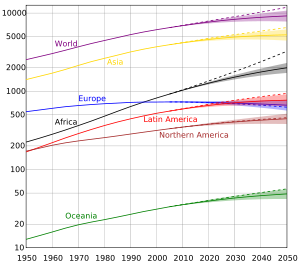
Different regions have different rates of population growth, but in the unusual case of the 20th century, the world saw the biggest increase in its population in human history due to medical advances and massive increase in agricultural productivity made by the Green Revolution.
In 2000, the United Nations estimated that the world's population was then growing at the rate of 1.14% (or about 75 million people) per year, down from a peak of 86 million per year in 1987. In the last few centuries, the number of people living on Earth has increased many times over. By the year 2000, there were 10 times as many people on Earth as there were 300 years ago. According to data from the CIA's 2005–2006 World Factbooks, the world human population increased by 203,800 every day. The 2007 CIA factbook increased this to 211,090 people every day.
Globally, the population growth rate has been steadily declining from its peak of 2.19% in 1963, but growth remains high in the Middle East and Sub-Saharan Africa.
In some countries there is negative population growth (i.e. net decrease in population over time), especially in Central and Eastern Europe (mainly due to low fertility rates) and Southern Africa (due to the high number of HIV-related deaths). Within the next decade, Japan and some countries in Western Europe are also expected to encounter negative population growth due to sub-replacement fertility rates.
Population growth which exceeds the carrying capacity of an area or environment results in overpopulation. Conversely, such areas may be considered "underpopulated" if the population is not large enough to maintain an economic system; however, many who do not view overpopulation as a serious problem fail to consider the sustainability of economic systems, the environmental degradation caused, and the ecological footprint of the existing population.
The United Nations states that population growth is rapidly declining due to the demographic transition. The world population is expected to peak at 9.2 billion in 2075.
Milestones
| Population (in billions) | 1 | 2 | 3 | 4 | 5 | 6 | 7 | 8 | 9 |
|---|---|---|---|---|---|---|---|---|---|
| Year | 1804 | 1927 | 1961 | 1974 | 1987 | 1999 | 2011 | 2024 | 2042 |
| Years elapsed | 123 | 34 | 13 | 13 | 12 | 12 | 13 | 18 |
These numbers show that the world's population has tripled in 72 years, and doubled in 38 years up to the year 1999. Including some more estimates, the world population has been doubled or will double in the following years (with two different starting points). Note how, during the 2nd millennium, each doubling has taken roughly half as long as the previous doubling.
| Starting at 250 millions | Starting at 375 millions | ||||||||||||
|---|---|---|---|---|---|---|---|---|---|---|---|---|---|
| Population (in billions) |
0.25 | 0.5 | 1 | 2 | 4 | 8 | 0.375 | 0.75 | 1.5 | 3 | 6 | ||
| Year | 950 | 1600 | 1804 | 1927 | 1974 | 2024 | 1420 | 1720 | 1875 | 1961 | 1999 | ||
| Years elapsed | 650 | 204 | 123 | 47 | 50 | 300 | 155 | 86 | 38 | ||||
Population distribution
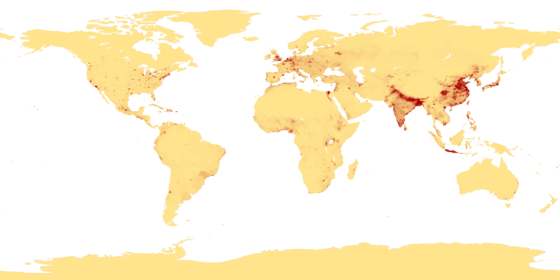
Asia accounts for over 60% of the world population with almost 3.8 billion people. The People's Republic of China and India alone comprise 20% and 17% respectively. Africa follows with 840 million people, 12% of the world population. Europe's 710 million people make up 11% of the world's population. North America is home to 514 million (8%), South America to 371 million (5.3%), and Australia 21 million.
The 15 most populous nations
Approximately 4.3 billion people live in these 15 countries, representing roughly two-thirds of the world's population. If added together, all nations in the European Union, with 494 million people – about 7.3% of world's population in 2006 – would be third in the list below.
| Country | Population (millions) |
Percentage (of world) |
|---|---|---|
| China | 1,321 | 19.84% |
| India | 1,132 | 16.96% |
| United States | 304 | 4.56% |
| Indonesia | 232 | 3.47% |
| Brazil | 187 | 2.80% |
| Pakistan | 163 | 2.44% |
| Bangladesh | 159 | 2.38% |
| Nigeria | 148 | 2.22% |
| Russia | 142 | 2.13% |
| Japan | 128 | 1.92% |
| Mexico | 107 | 1.60% |
| Philippines | 89 | 1.33% |
| Vietnam | 84 | 1.31% |
| Germany | 82 | 1.23% |
| Egypt | 81 | 1.13% |
| Total | 4,356 | 65.32% |
Ethnicity
The world is made up of hundreds of thousands of ethnic groups, and due to mass migration across the planet over millennia, it is impossible to tell how many people belonging to a certain ethnic group inhabit the earth. The single largest ethnic group on the planet by far is Han Chinese, which represents 19.73% of the global population. For comparison 6.06% of the planet's population is of full or partial Spanish ancestry, and on a wider scale 14.2% of earth's population is of Sub-Saharan descent (those identifying as 'Black').
Demographics of youth
According to the 2006 CIA World Factbook, around 27% of the world's population is below 15 years of age.
Before adding mortality rates, the 1990s saw the greatest number of raw births worldwide, especially in the years after 1995, despite the fact that the birth rate was not as high as in the 1960s. In fact, because of the 160 million-per-year raw births after 1995, the time it took to reach the next billion reached its fastest pace (only 12 years), as world population reached 6 billion people in 1999, when at the beginning of the decade, the reaching was designated for the year 2000, by most demographers. People aged 7 through 17 make up these births, today.
1985–1990 marked the period with the fastest yearly population change in world history. Even though the early 1960s had a greater growth rate than in the mid and late 1980s, the population change hovered around 83 million people in the five-year period, with an all-time growth change of nearly 88 million in 1990. The reason is because the world's population was greater in the mid and late 1980s (around 5 billion) than in the early 1960s (around 3 billion), which meant that the growth rate in the 1980s was no factor on the dramatic population change. People aged 17 to 22 make up these births, today.
Forecast of world population
| Year | Population (in billions) |
|---|---|
| 2010 | 6.9 |
| 2020 | 7.7 |
| 2030 | 8.4 |
| 2040 | 9.0 |
| 2050 | 9.5 |
In the long run, the future population growth of the world is difficult to predict. Birth rates are declining slightly on average, but vary greatly between developed countries (where birth rates are often at or below replacement levels), developing countries, and different ethnicities. Death rates can change unexpectedly due to disease, wars and catastrophes, or advances in medicine. The UN itself has issued multiple projections of future world population, based on different assumptions. Over the last 10 years, the UN had consistently revised these projections downward, until the 2006 revision issued March 14, 2007 revised the 2050 mid range estimate upwards by 273 million.
Alternately, the United States Census Bureau issued a revised forecast for world population that increased its projection for the year 2050 to above 9.4 billion people (which was the UN's 1996 projection for 2050), up from 9.1 billion people. A new United States Census bureau revision from June 18, 2008 has increased its projections further, to beyond 9.5 billion in 2050.
Other projections of population growth predict that the world's population will eventually crest, though it is uncertain exactly when or how. In some scenarios, the population will crest as early as the mid-21st century at under 9 billion, due to gradually decreasing birth rates, (the "low variant" of ), The "high variant" from the same source gives a population between 10 and 11 billion in 2050.
In other scenarios, disasters triggered by the growing population's demand for scarce resources will eventually lead to a sudden population crash, or even a Malthusian catastrophe (also see overpopulation and food security).
| Year | World | Africa | Asia | Europe | Latin America | US and Canada | Oceania |
|---|---|---|---|---|---|---|---|
| 2010 | 6,830,283 | 984,225 (14.4%) | 4,148,948 (60.7%) | 719,714 (10.5%) | 594,436 (8.7%) | 348,139 (5.1%) | 34,821 (0.5%) |
| 2015 | 7,197,247 | 1,084,540 (15.1%) | 4,370,522 (60.7%) | 713,402 (9.9%) | 628,260 (8.7%) | 363,953 (5.1%) | 36,569 (0.5%) |
| 2020 | 7,540,237 | 1,187,584 (15.7%) | 4,570,131 (60.6%) | 705,410 (9.4%) | 659,248 (8.7%) | 379,589 (5.0%) | 38,275 (0.5%) |
| 2025 | 7,851,455 | 1,292,085 (16.5%) | 4,742,232 (60.4%) | 696,036 (8.9%) | 686,857 (8.7%) | 394,312 (5.0%) | 39,933 (0.5%) |
| 2030 | 8,130,149 | 1,398,004 (17.2%) | 4,886,647 (60.1%) | 685,440 (8.4%) | 711,058 (8.7%) | 407,532 (5.0%) | 41,468 (0.5%) |
| 2035 | 8,378,184 | 1,504,179 (18.0%) | 5,006,700 (59.8%) | 673,638 (8.0%) | 731,591 (8.7%) | 419,273 (5.0%) | 42,803 (0.5%) |
| 2040 | 8,593,591 | 1,608,329 (18.7%) | 5,103,021 (59.4%) | 660,645 (8.0%) | 747,953 (8.7%) | 429,706 (5.0%) | 43,938 (0.5%) |
| 2045 | 8,774,394 | 1,708,407 (19.5%) | 5,175,311 (59.0%) | 646,630 (7.4%) | 759,955 (8.7%) | 439,163 (5.0%) | 44,929 (0.5%) |
| 2050 | 8,918,724 | 1,803,298 (20.2%) | 5,217,202 (58.5%) | 653,323 (7.3%) | 767,685 (8.6%) | 447,931 (5.0%) | 45,815 (0.5%) |
Predictions based on our growing population
Although Thomas Malthus, in 1798, incorrectly predicted that population growth would eventually outrun food supply by the middle of the 19th century, food prices in the early 21st century have finally risen sharply on a global scale with serious malnutrition spreading widely in step. In 1968, Paul R. Ehrlich reignited this argument with his book The Population Bomb, which predicted that "in the 1970s and 1980s hundreds of millions of people will starve to death", and helped give the issue significant attention throughout the 1960s and 1970s. The dire predictions of Ehrlich and other neo-Malthusians were vigorously challenged by a number of economists, notably Julian Simon.
On the opposite end of the spectrum there are a number of people who argue that today's low fertility rates in Europe, North America, Japan and Australia, combined with mass immigration, will have severe negative consequences for these countries.
Child poverty has been linked to people having children before they have the means to care for them. More recently, some scholars have put forward the Doomsday argument applying Bayesian probability to world population to argue that the end of humanity will come sooner than we usually think.
It should be noted that between 1950 and 1984, as the Green Revolution transformed agriculture around the globe, world grain production increased by 250%. The energy for the Green Revolution was provided by fossil fuels in the form of fertilizers (natural gas), pesticides (oil), and hydrocarbon fueled irrigation. The peaking of world hydrocarbon production ( Peak oil) may test Malthus and Ehrlich critics. As of May 2008, increased farming for use in biofuels, world oil prices at over $120 a barrel, global population growth, climate change, loss of agricultural land to residential and industrial development, and growing consumer demand in China and India have pushed up the price of grain. Food riots have recently taken place in many countries across the world.
The world population has grown by about four billion since the beginning of the Green Revolution and most believe that, without the Revolution, there would be greater famine and malnutrition than the UN presently documents (approximately 850 million people suffering from chronic malnutrition in 2005).
Number of humans who have ever lived
Estimates of the total number of people who have ever lived range approximately from 45 billion to 125 billion. Many of the more robust estimates fall into the range of 90 to 110 billion humans. It is impossible to make a precise count of the number of human beings who have ever lived for the following reasons:
- The set of specific characteristics which define a human being and distinguish early Homo sapiens from earlier or related species continues to be a subject of intense research and debate. It is thus not possible to know when to begin the count, nor which hominids to include.
- Even if the scientific community reached wide consensus regarding which characteristics distinguished human beings, it would be nearly impossible to pinpoint the time of their first appearance to even the nearest millennium because the fossil record is simply too sparse. Only a few thousand fossils of early humans have been found, most no bigger than a tooth or a knucklebone. These bone fragments are used to extrapolate the population distribution of millions of early human beings spread across the continents.
- Robust statistical data only exists for the last two or three centuries. Until the late 18th century, few nations, kingdoms, or empires had ever performed an accurate census. In many early attempts, the focus was on counting merely a subset of the people for purposes of taxation or military service. Even with the advent of agencies such as the United States Bureau of the Census, reliable census methods and technologies continue to evolve. All estimates of population sizes preceding the 18th century are estimates, and thus the margin of error for the total number of humans who have ever lived should be in the billions, or even tens of billions of people.
"Guesstimating the number of people ever born... requires selecting population sizes for different points from antiquity to the present and applying assumed birth rates to each period..."
According to one set of calculations based on 2002 data:
- The number who have ever been born is around 106 000 000 000.
- The world population in mid-2002 was approximately 6 215 000 000
- The percentage of those ever born who were living in 2002 was approximately 5.8%
